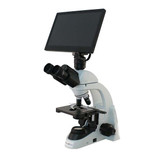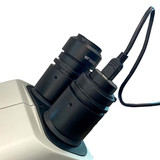Choosing a Veterinary Microscope for Your Clinic
Feb 25th 2022
Quality microscopes are a worthwhile investment in a veterinary practice’s laboratory investigations and case management. Commonly used for urinalysis, parasitology, microbiology and cytology, veterinary microscopes can be a valuable diagnostic tool for clinics of all sizes.
Too many veterinary professionals are using old, cheaply made microscope equipment that has not been p
…
Microscope Eyepiece Camera
Feb 24th 2022
Using a Microscope Eyepiece Camera
A microscope eyepiece camera can easily turn a monocular or binocular microscope that does not have a camera port into a digital microscope. A fairly inexpensive way to upgrade an older microscope that does not have a camera port, also known as a trinocular port, is by simply adding an eyepiece camera.
The eyepiece camera drops into an eyetube with inside diamete
…
Microscope Immersion Oil
Jul 21st 2021
Increase Resolution with Immersion Oil
Microscope objectives are intended to image specimens either through air or a medium of higher refractive index between the front lens and the specimen. A gain in resolution by a factor of about 1.5 is attained when immersion oil is substituted for air as the imaging medium.
Immersion oil contributes to two characteristics of the image viewed through the micr
…
Microscope Contrast Techniques
Apr 11th 2021
Microscope Contrast Techniques
When using a microscope with brightfield, some samples will have a natural contrast that is easily viewed, such as bright plants and flowers, metals, and pigments. Some samples can be stained to increase the microscope contrast. However, low contrast samples such as unstained bacteria, thin tissue slices, live cells, or reflective metal parts require the use of addit
…








